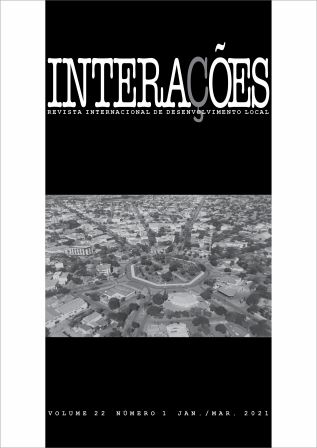Scientific analysis of urban green spaces and its ecosystem services
Keywords:
Extreme Events, Carbon Stock, Evapotranspiration, Green Infrastructure, Ecosystem ServicesAbstract
The accelerated urban and population growth in the last decades has intensified the need for research about urban ecosystem and their services associated with the urban population’s well-being through nature conservation. The acknowledgment of ecosystem services provided by Urban Green Spaces (UGSs) can support decision-making to promote urban sustainable development, therefore conserving and/or restoring ecosystem services and biodiversity aiming to adapt urban people to the forthcoming challenges of climate change. This article aims to assess how ecosystem services provided by UGSs have been evolved in the scientific community. A scientometric survey and a bibliographical analysis of the main articles helped to assess the current scientific knowledge, the main theoretical limitations and gaps, as well as the opportunities for advancing the knowledge on this subject. Results indicate that researches on ecosystem services in UGSs increased since 2005 at an annual exponential growth rate of 30%, especially in more developed countries. Bibliographical analysis points out that both regulatory and cultural ecosystem services in urban context are those which has been attributed higher importance, and that new methodologies are necessary to assess and possibly to value these services.
References
ANDERSSON-SKÖLD, Y. et al. A framework for assessing urban greenery's effects and valuing its ecosystem services. Journal of Environmental management, v. 205, p. 274-85, jan. 2018. DOI: https://doi.org/10.1016/j.jenvman.2017.09.071
ARAGÃO, L. E O. C. The rainforest's water pump. Nature, v. 489, p. 217-8, set. 2012. DOI: 10.1038/nature11485.
BOLUND, P.; HUNHAMMAR, S. Ecosystem services in urban areas. Ecological Economics, v. 29, n. 2, p. 293-301, maio 1999. DOI: https://doi.org/10.1016/S0921-8009(99)00013-0
COSTANZA, R. et al. The value of the world’s ecosystem services and natural capital. Nature, v. 387, p. 253-60, maio 1997. DOI: https://doi.org/10.1038/387253a0
COUTTS, C.; HAHN, M. Green infrastructure, ecosystem services, and human health. International Journal of Environmental Research and Public Health , v. 12, n. 8, p. 9768-98, 2015. DOI : 10.3390/ijerph120809768
DAVIES, Z. G. et al. Identifying potential sources of variability between vegetation carbon storage estimates for urban areas. Environmental Pollution, v. 183, p. 133-42, dez. 2013. DOI : https://doi.org/10.1016/j.envpol.2013.06.005
DAVIES Z. G. et al. Mapping an urban ecosystem service: quantifying above‐ground carbon storage at a city‐wide scale. Journal of Applied Ecology, v. 48, n. 5, p. 1125-34, out. 2011. DOI: https://doi.org/10.1111/j.1365-2664.2011.02021.x
DERKZEN, M. L. et al. Quantifying urban ecosystem services based on high resolution data of urban green space: an assessment for Rotterdam, the Netherland. Journal of Applied Ecology, v. 52, n. 4, p. 1020-32, 2015. DOI: https://doi.org/10.1111/1365-2664.12469
D’ODORICO, P. et al. Ecohydrology of Terrestrial Ecosystems. BioScience, v. 60, n. 11, p. 898-907, dez. 2010. DOI: https://doi.org/10.1525/bio.2010.60.11.6
DORENDORF, J. et al. Both tree and soil carbon need to be quantified for carbon assessments of cities. Urban Forestry & Urban Greening, v. 14, n. 3, p. 447-55, 2015. DOI: https://doi.org/10.1016/j.ufug.2015.04.005
ELMQVIST, T. et al. Benefits of restoring ecosystem services in urban areas. Current Opinion in Environmental Sustainability, v. 14, p. 101-8, jun. 2015. DOI: https://doi.org/10.1016/j.cosust.2015.05.001
ESCOBEDO, F. J.; KROEGER, T.; WAGNER, J. E. Urban forests and pollution mitigation: Analyzing ecosystem services and disservices. Environmental Pollution, v. 159, n. 8-9, p. 2078-87, ago./set. 2011. DOI: https://doi.org/10.1016/j.envpol.2011.01.010
GÓMEZ-BAGGETHUN, E.; BARTON, D. Classifying and valuing ecosystem services for urban planning. Ecological Economics, v. 86, p. 235-45, fev. 2013. DOI: https://doi.org/10.1016/j.ecolecon.2012.08.019
HAASE, D. et al. A quantitative review of urban ecosystem service assessments: concepts, models, and implementation. Ambio, a Journal of Environment and Society., v. 43, p. 413-33, maio 2014. DOI: https://doi.org/10.1007/s13280-014-0504-0
KABISCH, N.; QURESHI, S.; HAASE, D. Human-environment interactions in urban green spaces – a systematic review of contemporary issues and prospects for future research. Environmental Impact Assessment Review, v. 50, p. 25-34, jan. 2015. DOI: https://doi.org/10.1016/j.eiar.2014.08.007
LUEDERITZ, C. et al. A review of urban ecosystem services: six key challenges for future research. Ecosystem Services, v. 14, p. 98-112, ago. 2015. DOI: https://doi.org/10.1016/j.ecoser.2015.05.001
MILLENNIUM ECOSYSTEM ASSESSMENT [MEA]. Ecosystems and human well-being: biodiversity synthesis. Washington, DC: World Resources Institute, Island Press, 2005.
NIEMELÄ, J. et al. Using the ecosystem services approach for better planning and conservation of urban green spaces: a Finland case study. Biodiversity and Conservation, v. 14, v. 19, n. 11, p. 3225-43, out. 2010. DOI: https://doi.org/10.1007/s10531-010-9888-8
NIEMELÄ, J. Ecology of urban green spaces: the way forward in answering major research questions. Landscape and Urban Planning, v. 125, p. 298-303, maio 2014. DOI: https://doi.org/10.1016/j.landurbplan.2013.07.014
NOWAK, D. J. et al. Carbon storage and sequestration by trees in urban and community areas of the United States. Environmental Pollution, v. 178, p. 229-36, jul. 2013. DOI: https://doi.org/10.1016/j.envpol.2013.03.019
THE ECONOMICS OF ECOSYSTEMS AND BIODIVERSITY [TEEB]. The economics of ecosystems and biodiversity in national and international policy making. Editado por Patrick ten Brink. London; Washington: Earthscan. 2009.
WOLCH, J. R.; BYRNE, J.; NEWELL, J. P. Urban green space, public health, and environmental justice: the challenge of making cities ‘just green enough’. Landscape and Urban Planning, v. 125, p. 234-44, maio 2014. DOI: https://doi.org/10.1016/j.landurbplan.2014.01.017
Downloads
Published
How to Cite
Issue
Section
License
Direitos Autorais para artigos publicados nesta revista são do autor, com direitos de primeira publicação para a revista. Em virtude de aparecerem nesta revista de acesso público, os artigos são de uso gratuito, com atribuições próprias, em aplicações educacionais e não-comerciais.


